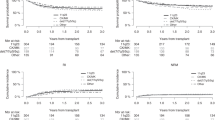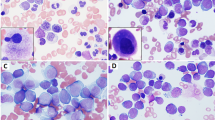Summary:
We retrospectively analysed the significance of FLT3 mutations in patients with acute myeloid leukemia (AML) having a normal karyotype, who were treated with high-dose chemotherapy and autologous peripheral blood stem cell transplantation (auto-PBSCT). In all, 34 patients with normal karyotype AML in first complete remission receiving high-dose chemotherapy and auto-PBSCT were analysed based on the presence or absence of FLT3/ITDs and FLT3/D835. They were 16 males and 18 females and with a median age of 41.5 years. FLT3/ITDs were detected in eight of 34 patients (23.5 %), and FLT3 D835 mutations in two of 34 patients (5.9%). White blood cell count (P=0.0087), serum concentration of lactate dehydrogenase (P=0.005), and percentages of peripheral blood (P=0.0131) and bone marrow (BM) blasts (P=0.0312) were significantly higher in patients showing the FLT3 mutations. Overall survival (OS) and disease-free survival (DFS) were similar between patients with or without FLT3 mutations (5 year DFS, 67.5 vs 68.55%, P=0.819; 5 year OS, 64.81 vs 78.88%, P=0.4457, by the log-rank test). FLT3 mutations demonstrate no further prognostic impact in patients with normal karyotype AML in first CR treated with high-dose chemotherapy and auto-PBSCT. Myeloablative chemotherapy supported by auto-PBSCT may overcome any poor prognostic implications of FLT3 mutations.
This is a preview of subscription content, access via your institution
Access options
Subscribe to this journal
Receive 12 print issues and online access
$259.00 per year
only $21.58 per issue
Buy this article
- Purchase on Springer Link
- Instant access to full article PDF
Prices may be subject to local taxes which are calculated during checkout

Similar content being viewed by others
References
Mrozek K, Heinonen K, Bloomfield CD . Clinical importance of cytogenetics in acute myeloid leukaemia. Best Pract Res Clin Haematol 2001; 14: 19–47.
Bloomfield CD, Lawrence D, Byrd JC et al. Frequency of prolonged remission duration after high-dose cytarabine intensification in acute myeloid leukemia varies by cytogenetic subtype. Cancer Res 1998; 58: 4173–4179.
Grimwade D, Walker H, Oliver F et al. The importance of diagnostic cytogenetics on outcome in AML: analysis of 1612 patients entered into the MRC AML 10 trial. The Medical Research Council Adult and Children's Leukaemia Working Parties. Blood 1998; 92: 2322–2333.
Slovak ML, Kopecky KJ, Cassileth PA et al. Karyotypic analysis predicts outcome of preremission and postremission therapy in adult acute myeloid leukemia: a Southwest Oncology Group/Eastern Cooperative Oncology Group Study. Blood 2000; 96: 4075–4083.
Gondo H, Harada M, Miyamoto T et al. Autologous peripheral blood stem cell transplantation for acute myelogenous leukemia. Bone Marrow Transplant 1997; 20: 821–826.
Harada M, Akashi K, Hayashi S et al. Granulocyte colony-stimulating factor-combined marrow-ablative chemotherapy and autologous blood cell transplantation for the treatment of patients with acute myelogenous leukemia in first remission. The Fukouka Bone Marrow Transplant Group. Int J Hematol 1997; 66: 297–301.
Turner AM, Lin NL, Issarachai S et al. FLT3 receptor expression on the surface of normal and malignant human hematopoietic cells. Blood 1996; 88: 3383–3390.
Lyman SD, Jacobsen SE . c-kit ligand and Flt3 ligand: stem/progenitor cell factors with overlapping yet distinct activities. Blood 1998; 91: 1101–1134.
Nakao M, Yokota S, Iwai T et al. Internal tandem duplication of the flt3 gene found in acute myeloid leukemia. Leukemia 1996; 10: 1911–1918.
Yokota S, Kiyoi H, Nakao M et al. Internal tandem duplication of the FLT3 gene is preferentially seen in acute myeloid leukemia and myelodysplastic syndrome among various hematological malignancies. A study on a large series of patients and cell lines. Leukemia 1997; 11: 1605–1609.
Kiyoi H, Naoe T, Nakano Y et al. Prognostic implication of FLT3 and N-RAS gene mutations in acute myeloid leukemia. Blood 1999; 93: 3074–3080.
Kottaridis PD, Gale RE, Frew ME et al. The presence of a FLT3 internal tandem duplication in patients with acute myeloid leukemia (AML) adds important prognostic information to cytogenetic risk group and response to the first cycle of chemotherapy: analysis of 854 patients from the United Kingdom Medical Research Council AML 10 and 12 trials. Blood 2001; 98: 1752–1759.
Whitman SP, Archer KJ, Feng L et al. Absence of the wild-type allele predicts poor prognosis in adult de novo acute myeloid leukemia with normal cytogenetics and the internal tandem duplication of FLT3: a cancer and leukemia group B study. Cancer Res 2001; 61: 7233–7239.
Frohling S, Schlenk RF, Breitruck J et al. Prognostic significance of activating FLT3 mutations in younger adults (16 to 60 years) with acute myeloid leukemia and normal cytogenetics: a study of the AML Study Group Ulm. Blood 2002; 100: 4372–4380.
Thiede C, Steudel C, Mohr B et al. Analysis of FLT3-activating mutations in 979 patients with acute myelogenous leukemia: association with FAB subtypes and identification of subgroups with poor prognosis. Blood 2002; 99: 4326–4335.
Rombouts WJ, Blokland I, Lowenberg B, Ploemacher RE . Biological characteristics and prognosis of adult acute myeloid leukemia with internal tandem duplications in the Flt3 gene. Leukemia 2000; 14: 675–683.
Kiyoi H, Towatari M, Yokota S et al. Internal tandem duplication of the FLT3 gene is a novel modality of elongation mutation which causes constitutive activation of the product. Leukemia 1998; 12: 1333–1337.
Yamamoto Y, Kiyoi H, Nakano Y et al. Activating mutation of D835 within the activation loop of FLT3 in human hematologic malignancies. Blood 2001; 97: 2434–2439.
Bennett JM, Catovsky D, Daniel MT et al. Proposed revised criteria for the classification of acute myeloid leukemia. A report of the French-American-British Cooperative Group. Ann Intern Med 1985; 103: 620–625.
Bennett JM, Catovsky D, Daniel MT et al. Proposal for the recognition of minimally differentiated acute myeloid leukaemia (AML-MO). Br J Haematol 1991; 78: 325–329.
Makino S, Harada M, Akashi K et al. A simplified method for cryopreservation of peripheral blood stem cells at −80 degrees C without rate-controlled freezing. Bone Marrow Transplant 1991; 8: 239–244.
Wheatley K . Current controversies: which patients with acute myeloid leukaemia should receive a bone marrow transplantation? – a statistician's view. Br J Haematol 2002; 118: 351–356.
Boissel N, Cayuela JM, Preudhomme C et al. Prognostic significance of FLT3 internal tandem repeat in patients with de novo acute myeloid leukemia treated with reinforced courses of chemotherapy. Leukemia 2002; 16: 1699–1704.
Schnittger S, Schoch C, Dugas M et al. Analysis of FLT3 length mutations in 1003 patients with acute myeloid leukemia: correlation to cytogenetics, FAB subtype, and prognosis in the AMLCG study and usefulness as a marker for the detection of minimal residual disease. Blood 2002; 100: 59–66.
Kainz B, Heintel D, Marculescu R et al. Variable prognostic value of FLT3 internal tandem duplications in patients with de novo AML and a normal karyotype, t(15;17), t(8;21) or inv(16). Hematol J 2002; 3: 283–289.
Beran M, Luthra R, Kantarjian H, Estey E . FLT3 mutation and response to intensive chemotherapy in young adult and elderly patients with normal karyotype. Leuk Res 2004; 28: 547–550.
Mayer RJ, Davis RB, Schiffer CA et al. Intensive postremission chemotherapy in adults with acute myeloid leukemia. Cancer and Leukemia Group B. N Engl J Med 1994; 331: 896–903.
Author information
Authors and Affiliations
Corresponding author
Rights and permissions
About this article
Cite this article
Yoshimoto, G., Nagafuji, K., Miyamoto, T. et al. FLT3 mutations in normal karyotype acute myeloid leukemia in first complete remission treated with autologous peripheral blood stem cell transplantation. Bone Marrow Transplant 36, 977–983 (2005). https://doi.org/10.1038/sj.bmt.1705169
Received:
Accepted:
Published:
Issue Date:
DOI: https://doi.org/10.1038/sj.bmt.1705169
Keywords
This article is cited by
-
Prospective randomization of post-remission therapy comparing autologous peripheral blood stem cell transplantation versus high-dose cytarabine consolidation for acute myelogenous leukemia in first remission
International Journal of Hematology (2018)
-
Comparable outcomes between autologous and allogeneic transplant for adult acute myeloid leukemia in first CR
Bone Marrow Transplantation (2016)
-
Autologous peripheral blood stem cell transplantation with granulocyte colony-stimulating factor combined conditioning regimen as a postremission therapy for acute myelogenous leukemia in first complete remission
International Journal of Hematology (2013)
-
Allo-SCT for high-risk AML-CR1 in the molecular era: impact of FLT3/ITD outweighs the conventional markers
Bone Marrow Transplantation (2012)



